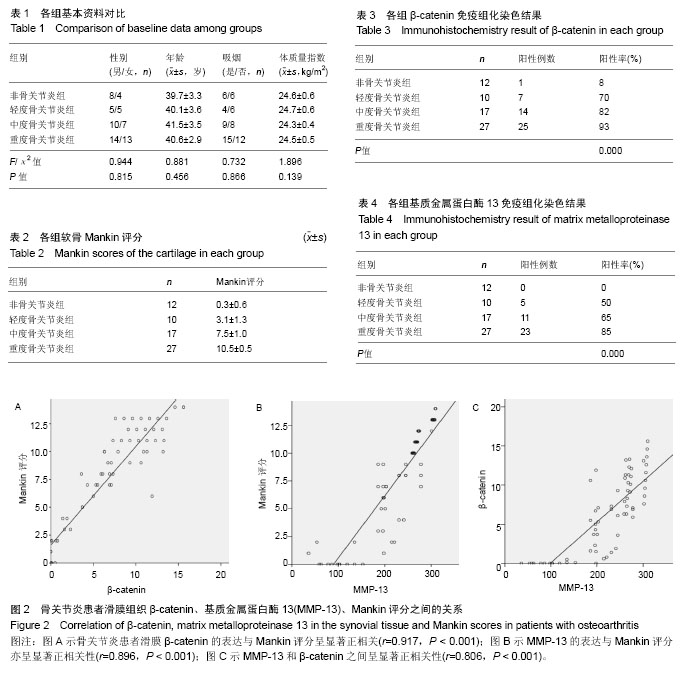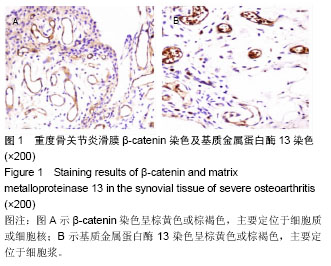中国组织工程研究 ›› 2018, Vol. 22 ›› Issue (16): 2472-2477.doi: 10.3969/j.issn.2095-4344.0294
• 骨组织构建 bone tissue construction • 上一篇 下一篇
骨关节炎滑膜组织中β-catenin和基质金属蛋白酶13的临床意义
李跃军1,朱卫国2,方钦正2,顾培伦1,高 鹏1,菅永志1,羊鹏飞1,董金波2
- 1石河子大学医学院,新疆维吾尔自治区石河子市 832000;2石河子大学医学院第一附属医院关节外科,新疆维吾尔自治区石河子市 832000
Clinical significance of beta-catenin and matrix metalloproteinase-13 in synovial tissue of osteoarthritis
Li Yue-jun1, Zhu Wei-guo2, Fang Qin-zheng2, Gu Pei-lun1, Gao Peng1, Jian Yong-zhi1, Yang Peng-fei1, Dong Jin-bo2
- 1School of Medicine, Shihezi University, Shihezi 832000, Xinjiang Uygur Autonomous Region, China; 2Department of Joint Surgery, First Affiliated Hospital of Medical College of Shihezi University, Shihezi 832000, Xinjiang Uygur Autonomous Region, China
摘要:
文章快速阅读:
.jpg) 文题释义:
基质金属蛋白酶13(MMP-13):在所有MMPs中MMP-13是最有效的Ⅱ型胶原降解酶。研究表明MMP-13是与骨关节病发病关系密切的金属蛋白酶成员之一。正常关节滑膜中很少有MMP-13表达,但在骨关节炎滑膜组织中表达增高异常明显,并且随着骨关节炎病情加重而升高,由此推断在骨关节炎关节的滑膜增生及关节软骨破坏病理过程中MMP-13发挥着重要作用。
β-catenin:是一种具有双重作用的蛋白,具有细胞黏附及信号传递活性,最早是在研究细胞黏附分子E-cadherin的过程中被发现。Wnt/β-catenin信号通路在骨关节炎病程中的作用已被大量动物实验和人标本试验验证。Wnt/β-catenin信号通路和MMP-13在骨关节炎的病理过程中都发挥重要作用,两者之间可能有某种潜在的联系。
文题释义:
基质金属蛋白酶13(MMP-13):在所有MMPs中MMP-13是最有效的Ⅱ型胶原降解酶。研究表明MMP-13是与骨关节病发病关系密切的金属蛋白酶成员之一。正常关节滑膜中很少有MMP-13表达,但在骨关节炎滑膜组织中表达增高异常明显,并且随着骨关节炎病情加重而升高,由此推断在骨关节炎关节的滑膜增生及关节软骨破坏病理过程中MMP-13发挥着重要作用。
β-catenin:是一种具有双重作用的蛋白,具有细胞黏附及信号传递活性,最早是在研究细胞黏附分子E-cadherin的过程中被发现。Wnt/β-catenin信号通路在骨关节炎病程中的作用已被大量动物实验和人标本试验验证。Wnt/β-catenin信号通路和MMP-13在骨关节炎的病理过程中都发挥重要作用,两者之间可能有某种潜在的联系。
.jpg) 文题释义:
基质金属蛋白酶13(MMP-13):在所有MMPs中MMP-13是最有效的Ⅱ型胶原降解酶。研究表明MMP-13是与骨关节病发病关系密切的金属蛋白酶成员之一。正常关节滑膜中很少有MMP-13表达,但在骨关节炎滑膜组织中表达增高异常明显,并且随着骨关节炎病情加重而升高,由此推断在骨关节炎关节的滑膜增生及关节软骨破坏病理过程中MMP-13发挥着重要作用。
β-catenin:是一种具有双重作用的蛋白,具有细胞黏附及信号传递活性,最早是在研究细胞黏附分子E-cadherin的过程中被发现。Wnt/β-catenin信号通路在骨关节炎病程中的作用已被大量动物实验和人标本试验验证。Wnt/β-catenin信号通路和MMP-13在骨关节炎的病理过程中都发挥重要作用,两者之间可能有某种潜在的联系。
文题释义:
基质金属蛋白酶13(MMP-13):在所有MMPs中MMP-13是最有效的Ⅱ型胶原降解酶。研究表明MMP-13是与骨关节病发病关系密切的金属蛋白酶成员之一。正常关节滑膜中很少有MMP-13表达,但在骨关节炎滑膜组织中表达增高异常明显,并且随着骨关节炎病情加重而升高,由此推断在骨关节炎关节的滑膜增生及关节软骨破坏病理过程中MMP-13发挥着重要作用。
β-catenin:是一种具有双重作用的蛋白,具有细胞黏附及信号传递活性,最早是在研究细胞黏附分子E-cadherin的过程中被发现。Wnt/β-catenin信号通路在骨关节炎病程中的作用已被大量动物实验和人标本试验验证。Wnt/β-catenin信号通路和MMP-13在骨关节炎的病理过程中都发挥重要作用,两者之间可能有某种潜在的联系。摘要
背景:Wnt/β-catenin信号通路在骨关节炎病程中的作用已被大量动物实验和人标本试验验证。Wnt/β-catenin信号通路和基质金属蛋白酶13(matrix metalloproteinases,MMP-13)在骨关节炎的病理过程中都发挥重要作用,两者之间可能有某种潜在的联系。
目的:检测β-catenin和MMP-13在骨关节炎滑膜中的表达水平,探讨它们在骨关节炎发病过程中的相关性。
方法:骨关节炎组取自行人工膝关节置换术或膝关节镜诊治术骨关节炎患者的关节滑膜组织,共54例;非骨关节炎组取创伤后行截肢术健康青年患者自愿捐赠的正常膝关节滑膜组织,共12例。根据改良的Mankin关节软骨病理评分标准分为非骨关节炎组及轻度、中度、重度骨关节炎组。采用免疫组化检测β-catenin和MMP-13在骨关节炎患者滑膜组织中的表达,并进行相关性分析。
结果与结论:①MMP-13免疫组化染色结果:非骨关节炎组全部为阴性;轻度骨关节炎组5例阳性、阳性率50%,中度骨关节炎组11例阳性、阳性率65%,重度骨关节炎组23例阳性、阳性率85%;②β-catenin免疫组化染色结果:非骨关节炎组1例染色阳性,阳性率为8%;轻度骨关节炎组7例阳性,阳性率70%;中度骨关节炎组14例阳性,阳性率82%;重度骨关节炎组25例阳性,阳性率93%;③β-catenin与MMP-13在骨关节炎患者滑膜中的含量呈现明显的正相关关系(r=0.806,P < 0.001),其含量亦随着关节退变程度的加重而增加;④结果提示,MMP-13和β-catenin在骨关节炎组滑膜组织中均表现为高表达状态,两者在骨关节炎与非骨关节炎组表达差异有显著性意义,并且共同在骨关节炎病程中发挥作用。骨关节炎病变过程中β-catenin和MMP-13均发挥着重要的调控作用,并且MMP-13与β-catenin在参与骨关节炎软骨退变和滑膜炎症反应等病理变化过程中密切相关,这为骨关节炎的靶向基因治疗提供了新的理论方向和实验依据。
中国组织工程研究杂志出版内容重点:组织构建;骨细胞;软骨细胞;细胞培养;成纤维细胞;血管内皮细胞;骨质疏松;组织工程
ORCID: 0000-0002-5590-0706(李跃军)
中图分类号:


.jpg) 文题释义:
基质金属蛋白酶13(MMP-13):在所有MMPs中MMP-13是最有效的Ⅱ型胶原降解酶。研究表明MMP-13是与骨关节病发病关系密切的金属蛋白酶成员之一。正常关节滑膜中很少有MMP-13表达,但在骨关节炎滑膜组织中表达增高异常明显,并且随着骨关节炎病情加重而升高,由此推断在骨关节炎关节的滑膜增生及关节软骨破坏病理过程中MMP-13发挥着重要作用。
β-catenin:是一种具有双重作用的蛋白,具有细胞黏附及信号传递活性,最早是在研究细胞黏附分子E-cadherin的过程中被发现。Wnt/β-catenin信号通路在骨关节炎病程中的作用已被大量动物实验和人标本试验验证。Wnt/β-catenin信号通路和MMP-13在骨关节炎的病理过程中都发挥重要作用,两者之间可能有某种潜在的联系。
文题释义:
基质金属蛋白酶13(MMP-13):在所有MMPs中MMP-13是最有效的Ⅱ型胶原降解酶。研究表明MMP-13是与骨关节病发病关系密切的金属蛋白酶成员之一。正常关节滑膜中很少有MMP-13表达,但在骨关节炎滑膜组织中表达增高异常明显,并且随着骨关节炎病情加重而升高,由此推断在骨关节炎关节的滑膜增生及关节软骨破坏病理过程中MMP-13发挥着重要作用。
β-catenin:是一种具有双重作用的蛋白,具有细胞黏附及信号传递活性,最早是在研究细胞黏附分子E-cadherin的过程中被发现。Wnt/β-catenin信号通路在骨关节炎病程中的作用已被大量动物实验和人标本试验验证。Wnt/β-catenin信号通路和MMP-13在骨关节炎的病理过程中都发挥重要作用,两者之间可能有某种潜在的联系。